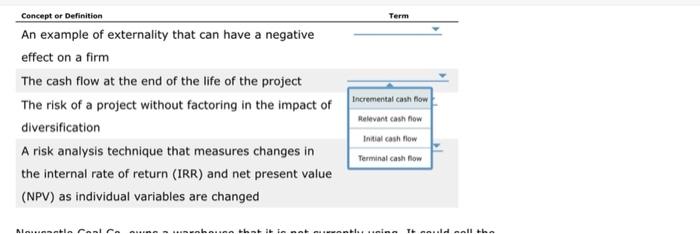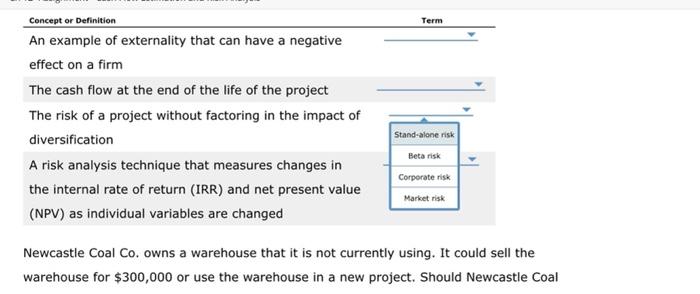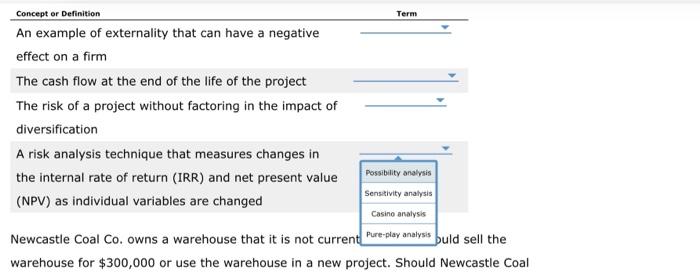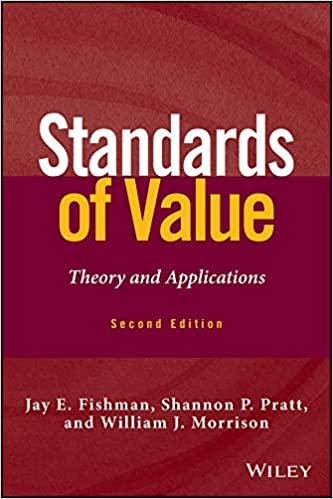1. Concepts used in cash flow estimation and risk analysis You can come across different situations in your life where the concepts from capital budgeting will help you in evaluating the situation and making calculated decisions. Consider the following situation: The following table contains five definitions or concepts. Identify the term that best corresponds to the concept or definition given. Concept or Definition An example of externality that can have a negative effect on a firm The cash flow at the end of the life of the project The risk of a project without factoring in the impact of diversification A risk analysis technique that measures changes in the internal rate of return (IRR) and net present value (NPV) as individual variables are changed Term Concept or Definition An example of externality that can have a negative effect on a firm The cash flow at the end of the life of the project The risk of a project without factoring in the impact of diversification A risk analysis technique that measures changes in Term Beta risk Corporate risk Cannibalization Exchange-rate risk Concept or Definition An example of externality that can have a negative effect on a firm The cash flow at the end of the life of the project The risk of a project without factoring in the impact of diversification A risk analysis technique that measures changes in the internal rate of return (IRR) and net present value (NPV) as individual variables are changed Mable Cont Co Auna Term Incremental cash flow Relevant cash flow Initial cash flow Terminal cash flow haung that it in not thing Tould all tha Concept or Definition An example of externality that can have a negative effect on a firm The cash flow at the end of the life of the project The risk of a project without factoring in the impact of diversification A risk analysis technique that measures changes in the internal rate of return (IRR) and net present value (NPV) as individual variables are changed Term Stand-alone risk Beta risk Corporate risk Market risk Newcastle Coal Co. owns a warehouse that it is not currently using. It could sell the warehouse for $300,000 or use the warehouse in a new project. Should Newcastle Coal Concept or Definition An example of externality that can have a negative effect on a firm The cash flow at the end of the life of the project The risk of a project without factoring in the impact of diversification A risk analysis technique that measures changes in the internal rate of return (IRR) and net present value (NPV) as individual variables are changed Term Possibility analysis Sensitivity analysis Casino analysis Newcastle Coal Co. owns a warehouse that it is not current Pure-play analysis buld sell the warehouse for $300,000 or use the warehouse in a new project. Should Newcastle Coal Newcastle Coal Co. owns a warehouse that it is not currently using. It could sell the warehouse for $300,000 or use the warehouse in a new project. Should Newcastle Coal Co. include the value of the warehouse as part of the initial investment in the new project? No, because the cost of the warehouse is a sunk cost. No, because the company will still be able to sell the warehouse once the project is complete. O Yes, because the firm could sell the warehouse if it didn't use it for the new project. A paper manufacturer has built a plant that meets all government-mandated environmental regulations, but the plant still produces an unpleasant odor when it is being operated. Many residents in the area dislike the paper mill because of these unpleasant odors. This is an example of externality. A paper manufacturer has b environmental regulations, b operated. Many residents in odors. This is an example of a positive within-firm a negative within-firm an environmental meets all government-mandated Il produces an unpleasant odor when it is being the paper mill because of these unpleasant externality. Grade It Now Save & Continue















